#but at the core of that even was the fact that Buck finds intrinsic self-worth in his ability to *do* for other people
Note
I’ve seen a lot of people speculate that Buck is spiraling towards some emotional breakdown (paralleling what we’re currently seeing with Eddie) and that we’ll get a role reversal of Eddie taking care of Buck, helping him through it, and that sounds great, but what I’m stuck on is.. what would be Buck’s breaking point? what would be the thing that actually sends him into a breakdown?
I mean, physically, we’ve seen the guy get his throat cut open on a restaurant floor, bombed, leg crushed, suffer a pulmonary embolism, and get caught in a tsunami all in within what a year and change?
Emotionally, we’ve seen him go through the various heartbreaks of being “the one left” in his relationships, lost vics, unethical therapists, finding one of his best friends stabbed/bleeding out, sister kidnapped, thinking he was to blame for the death of his best friend’s son, watching said best friend get shot in front of him, learned his family kept a lifelong secret of a SIBLING from him and that he was only born to save said sibling (and couldn’t), grew up with emotionally absent/neglectful parents, held hostage,“left behind”/feeling isolated at various points.
WHAT could the writers even do at this point to spur a breakdown? to be the catalyst for a trauma recovery storyline when none of the above has done so already???
Anon, the fastest, surest way to break Buck is to leave him behind. Not just physically, but emotionally. See, right now, his life and the lives of the people around him are pure chaos: Maddie and Chimney are back, but they're broken up, Eddie is fragile, and Christopher needs support. Right now, Buck is probably the most stable he's been in months. He's not sadistic, he doesn't delight in his loved ones' pain, but suffering = purpose. Buck makes himself useful by tending to and healing the wounds of others. That is in his nature. Right now, Buck's own life is a mess, but so are the lives of everyone else he loves.
But Eddie is on the upswing. Maddie and Chimney will get back together eventually, and he will still be left in his mess, because while he was taking care of everyone else, he neglected to take care of himself. So where does that leave him? Left behind again. While everyone else is off enjoying their newfound happiness and stability, he will be exactly where he was left, slumming through the mire of his own tragedy.
Do I think Buck's breakdown is going to be like Eddie's? No. Eddie's breakdown was violent, explosive, decades worth of grief and anger finally erupted like a volcano. But do I think Buck is going to breakdown in a way that is very in character for him (shouting, crying, hurting himself in some way, shape, or form)? Absolutely.
I hope they crack him like an egg :)
#The thing with Buck - and this is where he and Eddie are/were similar - is: there is a lot you can do to him physically that would simply#not break or phase him. Both Eddie and Buck have very detached and disturbing ways of viewing their bodies.#Both see them - or have seen them - as instruments for other people and not homes that they themselves inhabit#So when you mention the physical aspect of all things Buck has endured and survived it's like... Yeah#Because his body is (at the end of the day) just an object to be used for the sake of other people.#Which is one of the reasons why being taken off the job in Season 3 almost took him out#but at the core of that even was the fact that Buck finds intrinsic self-worth in his ability to *do* for other people#If you take away that ability to *do*#then you take away everything that (he thinks) gives him purpose and makes him who he is#So it was never injury or near-death that was going to break Buck#Not even being raped by the therapist because (again) his body = not *his* body#but not being able to fix the people he loves#not because they don't want him to but because there's nothing to fix? Because he's the only one left behind who is still broken and#tortured? Oh yeah that's going to fucking KILL him#jack answers mail#5b speculation#6a speculation
39 notes
·
View notes
Text
Thelem-Ra and the Princesses of Power
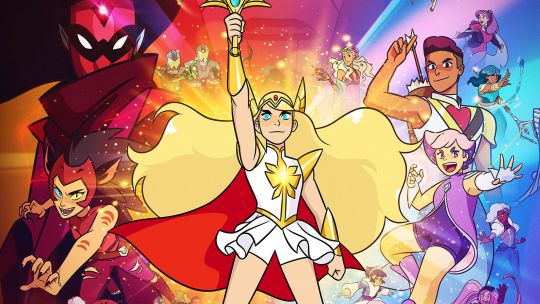
Due to strictly enforced gender norms, I wasn’t allowed to be obsessed with the original She-Ra cartoon. I could play with a friend’s sister’s She-Ra toy, but I never dared ask for my own.
That’s partly why Netflix’s remake She-Ra and the Princesses of Power means so much to me. Not only is it a version I can can openly discover and geek out over, but the characters’ wide range of age, gender expression and body type makes the fantasy realm of Etheria into a playground for the imagination -- one makes fans like me feel specifically included, even if it’s mainly aiming to entertain kids.
Any storytelling that draws from mystical currents will end up echoing familiar tropes and ideas from our own world. Attempts to portray existing magickal practices accurately almost always disappoint, as they did in Netflix’s other “princess of power” story, The Chilling Adventures of Sabrina (which is really entertaining nevertheless).
Isn’t it funny how the stories which offer up a wealth of artistic inspiration for magic often prove more durable than those depicting “real-life” magic use? The more abstract the characters’ powers are, the more possibilities we see in exploring them ourselves, and the more permission we feel to make something truly our own.
In the new She-Ra’s case (and in similar shows, like Steven Universe), magic is married to technology in a way that kids watching today will intrinsically understand, aligning neatly with post-modern chaos magick traditions.
In terms of old-school stuff, the Princesses’ magic is elemental in nature -- an expression of the soul of their homeworld, and a tool for regulating planetary harmony. The show departs from the classical elements of Earth, Air, Fire, Water, etc., which is fine, because their planet is not our planet, and its properties are still being revealed... to the characters, as well as to us.
But let’s not overlook that the very idea of “Princesses of Power” is old-school, and has a deep footprint in the history of tarot -- particularly the one crafted by the Dark Lord himself, Aleister Crowley.
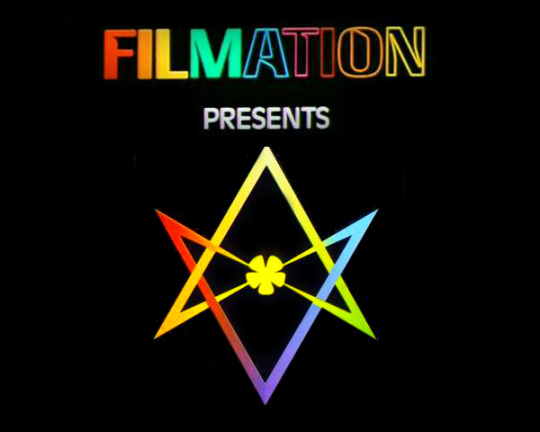
Before Crowley’s Thoth deck, the tarot’s court cards historically consisted of King, Queen, Knight, and Page -- a total sausage-fest, though Pamela Colman Smith brought out a wonderful androgyny in her illustration of the Pages (and in many of her deck’s other figures), which seems to even out the gender spectrum a bit, and is partly why the deck remains appealing to new users over a century later.
Conceived in the 1930s, Crowley’s court consists of a Knight, a Queen, a Prince, and a Princess. This “modern” twist must have seemed terribly progressive at the time, dethroning the King and elevating the court’s lowest ranking member (a page is just a humble servant of the royal court), consecrating that role as female.
You could write an entire book about the gender problems in Thelema (the religion founded by Crowley, which remains popular today). In fact, that book probably exists already, and contemporary Thelemites are continually exploring and re-examining the way our evolving social and scientific views of gender mesh with their religion’s core beliefs.
For now, all that’s important is that Crowley took a humble servant and elevated her to a PRINCESS OF POWER.

The four roles in the tarot’s court each correspond to a different classical element, the Page/Princess’s being Earth. And each of these four earthy figures is herself an expression of the classical elements: Fire of Earth (Wands), Water of Earth (Cups), Air of Earth (Swords), and Earth of Earth (Pentacles, or in Crowley’s case, Disks).
Exploring these cards in an earlier lesson, I wrote:
“The Page’s defining quality is not sex but immaturity, a word which inspires unnecessarily negative associations. Let’s not forget the raw potential we find in the young and/or untested, or the curiosity and vivacity they may bring to their work. As such, each of the four Pages represents a latent untamed force for change.”
What I love about Lady Frieda Harris’s illustrations in the Thoth deck is that the Princesses are all portrayed as doing something. These images could be pulled from the opening credits of She-Ra.
Think about that: she drew them as superheroes. The 1930s were the period when these kinds of heroes began to proliferate in comics, and Superman himself debuted in 1938 -- the same year Crowley and Harris began working on the Thoth deck.

Like She-Ra’s heroines, our tarot Princesses owe all their strength (as well as their weakness) to their signature elements, though in Crowley’s world there is a clear elemental hierarchy, due to spiritual ideas imparted by Western esotericism. As such, the Princess of Disks (Earth of Earth) sits at the bottom of the totem pole.
This kind of hierarchical thinking (and binary gender) is exactly what drives many people away from traditional forms of magick. I sympathize, and agree that we should never stop challenging these ideas.
However, what really we see in the Thoth deck is a setup for an archetypal story in which the low are made high; in which Princesses serve as the catalyst for changes that transform reality itself.
Just like Ace -- the lowest number in the minor arcana, but a symbol of tremendous power -- the Princess represents a place to build upward and outward from. Though she mirrors the queen in her gender, it’s the King/Knight she reflects in her agency and authority.
“The Princess is the throne of her Ace,” observes Thelemic teacher and author Lon Milo Duquette. In his book The Chicken Qabalah, he writes at length about the importance of Princesses: “They are positioned at the lowest end of our elemental universe, but they also embody the foundation of our universe.”
Awakening and exploring our Princess nature will gradually help us “escape the prison of matter” and “live in the bliss of the highest world.”
He even presents a diagram that shows how you can use the Princess and Ace-through-Ten cards to divide up the globe -- a handy tool for readings involving a geographical component.
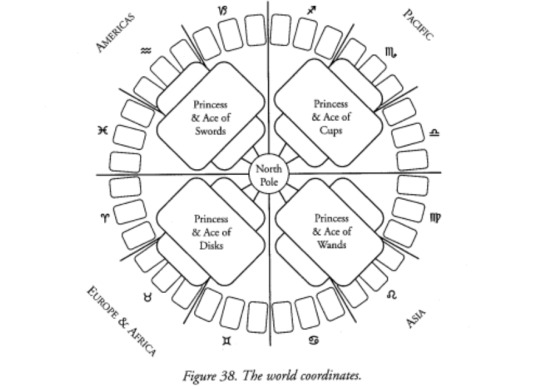
In the Netflix show, Adora is offered a very similar view of her world by First-Ones avatar Light Hope, who reveals how the Princesses -- each an expression of their respective element -- are all interconnected as regulators of Etheria’s holistic balance.

Of course, this is just an abstract diagram of Etheria’s actual geography. Entrapta’s model in the same scene shows that these centers of power are just as unevenly dispersed on Etheria as they are on our own planet.

Duquette’s book offers a qabalistic Creation myth based on these feudal archetypes, which may explain why royal figures still play such a prominent role in our storytelling.
“The you that you think is you is not you,” he explains. “It is a dream you. In fact, the you that you think is you is a dreamer inside a dreamer inside a dreamer inside a dreamer. You are the King of the universe, who has fallen asleep and is dreaming he is the Queen, who has fallen asleep and is dreaming she is the Prince, who has fallen asleep and is dreaming he is a sleeping princess.”
In Duquette’s fairytale of Creation, the Prince and Princess are twins birthed by the Queen -- different in sex, but alike in power. HELLO PEOPLE, this is the exact premise of the original She-Ra cartoon.

Within the new show, we see the struggle of a world straining to evolve in two opposing directions.
The Fright Zone is a technocratic military junta which only managed to come into power via political exploitation, capturing the Black Garnet runestone from the family of Scorpia, Etheria’s last “slumbering” princess.
One could compare the Fright Zone’s hierarchy to that of the classic Rider-Waite-Smith court cards, in which Hordak serves as King, Shadow Weaver as Lord, Force Captains are Knights, and all the the various wanna-be’s (including Adora and Catra in the first episode), servants, robots, and various scavengers remain in the Peasant class.
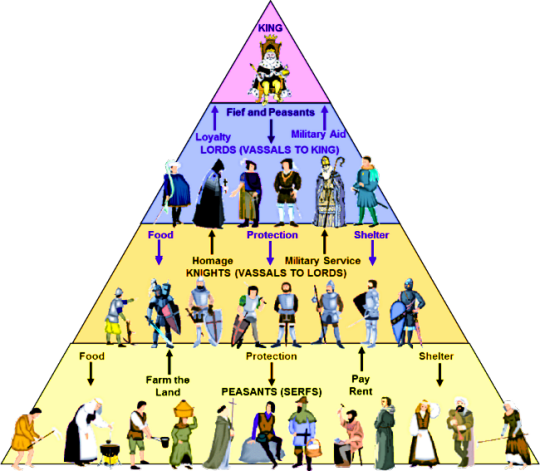
It’s not clear yet how the rest of Etheria is governed. It bucks this traditional structure, resulting in a lumpy sort of meritocracy in which those with the most magical power wield the most influence, but rulers are mainly tasked with maintaining harmony and protecting their subjects against external invasion. There’s evidence of a soldier class, but the “lowest” citizens we encounter are shown existing peacefully in (apparently) self-governing tribal cultures. They don’t serve the Princesses, they simply enjoy the freedom afforded to them by the Princesses’ rule. People live for love, for pleasure, for adventure, and/or the pursuit of intellectual aims.
(The only exception seems to be Entrapta, the Silicon Valley tech-bro stand-in who presides over her own servant class of attendants and robots. And it’s worth mentioning that she’s also the only Princess whose power isn’t anchored to an elemental source.)
In this sense, Etheria is an impressive embodiment of Thoth deck court structure, populated by Queens, industrious “princes” like Bow and SeaHawk, and true Princesses -- “Every man and every woman is a star,” with plenty of room to accommodate those who present neither as fully male or female, those with magical powers and those without.
But if you’ve already read this far, let’s take this one step even further and look at how SHE-RA IS ALSO A KNIGHT.
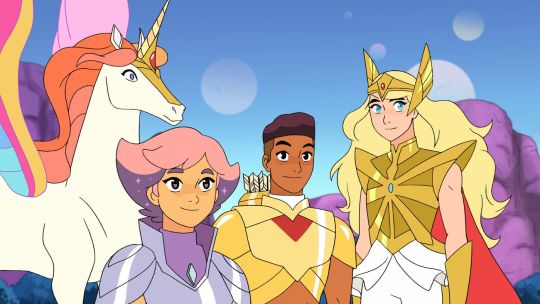
That’s right, you heard me: everything that Adora symbolizes as Princess, She-Ra articulates as a Knight. She even gets a horse! And a sword, and a shield! Note that Adora hasn’t really changed: she was a Knight in Hordak’s world also. She has simply relocated from one symbolic reality to another -- a more Thelemic one, in which Knights are kings. Thus, as She-Ra, she becomes Hordak’s symbolic equal.
And note that Noelle Stevenson’s re-imagining of the series is entitled “She-Ra and the Princesses of Power,” as opposed to the original title “She-Ra: Princess of Power.” She is of their ilk, but different. As Perfuma might say: “She is the She-Ra.”
Symbolically, Adora contains all the elemental potential of a Princess who must still evolve and struggle to awaken. She-Ra, however, is the elemental Fire that awaits on the other side -- the King who dreams he is a Queen, who dreams she is a Prince, who dreams he is a Princess. We know from Light Hope that She-Ra’s lineage extends thousands of years. She is not a person, she’s a function -- and that function is to protect Etheria by transforming reality.
In other words: Adora’s glorious transformation into She-Ra is a microcosm of Etheria’s transformation, which She-Ra herself was created to oversee.
youtube
In this way, the series bears the greatest resemblance to Alan Moore’s tremendous graphic novel Promethea, which tells the story of an ordinary young woman named Sophie who discovers she’s the latest incarnation of a mythical “science heroine” -- who may or may not have been created to usher in the Apocalypse. And she is guided in this process by other Prometheas, who represent an interesting range of ethnicities, body types, and genders.
Sophie’s exploration of her own newfound identity sends her on an odyssey that matches many beats in Adora’s. What are the limits of her new powers? How can she learn to transform at will? What dangers will this confer on her loved ones? Which parts of her belong to Sophie, and which to Promethea?
These are classic superhero problems, but Sophie’s quest is one that’s specifically designed to transform the reader as well: Moore has crafted a story that also serves as a primer for modern occult traditions, including tarot cards.

While Moore looks beyond Thelema, the works of Aleister Crowley remain a key influence -- the horny old magician even appears as a recurring character, in a handful of cheeky cameo roles.
Like She-Ra, Promethea points to the golden thread of continuity linking the individual and the divine. That’s a birthright that even the humblest, most overlooked person shares with the rest of humanity, but our world’s prevailing powers do everything they can to conceal that truth. Our own senses play tricks on us as well, supporting a view of the world in which we remain small and powerless, in which our lives, our suffering, our deaths, mean nothing.
The artists mentioned in this post -- Smith, Crowley, Duquette, Harris, Moore, Stevenson -- might not agree on everything, but they share the same quest: to awaken all these slumbering princesses. That includes you, dear reader. Wake up, your kingdom needs you!
Our language has another word for this sacred process: animation.
This is why you shouldn’t feel silly enjoying She-Ra or any other fantasy, at any age. This is why little girls shouldn’t be discouraged from play-acting as princesses (and neither should little boys). Society can only stand to improve from humans exploring their Princess powers. Many of these magical abilities will prove to be connected to life-saving (perhaps even civilization-saving) advantages further down the road. Magic is real, and we all stand to benefit from it.
“The clothes you're wearing, the room, the house, the city that you're in. Everything in it started out in the human imagination,” Moore writes in Promethea. “Your lives, your personalities, your whole world. All invented. All made up. All the wars, the romances. The masterpieces and the machines. And there's nothing here but a funny little twist of amino acids, playing a marvelous game of pretend.”
For the honor of Grayskull, it’s time to conduct yourself accordingly.

Have a tarot reading request or tarot-related question for Arcanalogue? Ask here. Tips accepted (but not required) via Venmo, @arcanalogue. Or support my Patreon? I’d love that.
157 notes
·
View notes